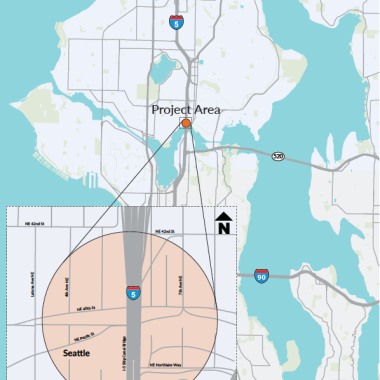Project overview
This project will build a stormwater treatment facility beneath the north end of the I-5 Ship Canal Bridge. This facility will capture, carry, and clean stormwater runoff from I-5 by removing harmful pollutants before the water flows into the ship canal.
What to expect
The project is currently in planning phase to develop concepts that enhance stormwater runoff treatment from existing roads and infrastructure with an emphasis on green infrastructure retrofits. The project concept must prioritize benefits to salmon recovery and ecosystem health, reducing toxic pollution, and addressing health disparities. The project team is evaluating existing conditions of the project area and engaging with the community to determine values, impacts and design considerations to ensure the design maximizes value to the public.
Environmental justice assessment
An Environmental Justice Assessment (EJA) will be completed for this project. These assessments are conducted for significant agency action (SAAs) that could harm the environment or impact how environmental benefits are distributed to overburdened communities (OBCs) or vulnerable populations (VPs). An EJA guides decision-making to ensure fair distribution of environmental benefits, reduce environmental harms and address disparities in both environmental and health outcomes. Meaningful engagement with affected communities is a crucial aspect of this process.
Stormwater runoff is the leading source of pollution in Puget Sound and nearby waterways, impacting the health of communities, ecosystems, and wildlife. This project will focus on treating harmful pollutants, such as 6PPD, a chemical used in tires that is toxic to salmon, along with other contaminants found in stormwater runoff. By addressing these pollutants, we can help protect local waterways, promote healthier ecosystems, and support the well-being of our community.
Healthy Environment for All (HEAL) Act
This project is also subject to Washington's environmental justice law, known as the Healthy Environment for All (HEAL) Act, which requires WSDOT to conduct environmental justice assessments (EJA) for significant agency actions (SAAs). SAAs are actions initiated after July 1, 2023, and consist of WSDOT transportation projects and grants of $15 million or more, new grant or loan programs, agency request legislation and rulemaking.
Environmental justice in Washington State, as provided in the HEAL Act, addresses disproportionate environmental and health impacts in all laws, rules, and policies by prioritizing vulnerable populations and overburdened communities, the equitable distribution of resources and benefits, and eliminating harm (RCW 70A.02.010)
Agency/Partner Coordination and Meetings
Technical Working group (TWG)
The TWG consist of public works, engineering, and planning staff from local, regional, state and tribal entities. The TWG serves in an advisory role to WSDOT providing technical feedback at multiple steps in the pre-design process.
Executive Working Group (EWG)
In the event this project finds agency partners to collaborate with, an EWG may be established to ensure the project is maximizing benefits to the surrounding communities.
Community Engagement
Community engagement will be conducted throughout the project. Specific engagement opportunities will be updated as the project advances.

